Charge Carrier Transport Behavior and Dielectric Properties of BaF2:Tb3+ Nanocrystals
Abstract
1. Introduction
2. Materials and Methods
3. Results and Discussion
4. Conclusions
Author Contributions
Funding
Conflicts of Interest
References
- Luo, Q.; Fan, X.; Qiao, X.; Yang, H.; Wang, M.; Zhang, X. Eu2+-doped glass ceramics containing BaF2 nanocrystals as a potential blue phosphor for UV-led. J. Am. Ceram. Soc. 2009, 92, 942–944. [Google Scholar] [CrossRef]
- Biswas, K.; Sontakke, A.D.; Sen, R.; Annapurna, K. Luminescence properties of dual valence Eu doped nano-crystalline BaF2 embedded glass-ceramicsand observation of Eu2+→Eu3+ energy transfer. J. Fluoresc. 2012, 22, 745–752. [Google Scholar] [CrossRef] [PubMed]
- Moine, B.; Pedrini, C.; Courtois, B. Photoionization and luminescences in BaF2:Eu2+. J. Lumin. 1991, 50, 31–38. [Google Scholar] [CrossRef]
- Shi, C.; Xie, Z.; Deng, J.; Dong, Y.; Yang, X.; Hu, Y.; Tian, Y.; Kan, Y.; Chert, G. Thermoluminescence of BaF2:RE(Ce, Dy, Eu) Crystals. J. Electron Spectrosc. Relat. Phenom. 1996, 79, 87–90. [Google Scholar]
- Maghrabi, M.; Townsend, P.D. Thermoluminescence spectra of rare earth doped Ca, Sr and Ba fluorides. J. Phys. Condens. Matter 2001, 13, 5817–5831. [Google Scholar] [CrossRef]
- Sorokin, N.I.; Sobolev, B.P. Nonstoichiometric fluorides—Solid electrolytes for electrochemical devices: A review. Crystallogr. Rep. 2007, 52, 842–863. [Google Scholar] [CrossRef]
- Sata, N.; Eberman, K.; Eberl, K.; Maier, J. Mesoscopic fast ion conduction in nanometre-scale planar heterostructures. Nature 2000, 408, 946–949. [Google Scholar] [CrossRef]
- Wagner, V.; Kugler, A.; Pachr, M.; Šumbera, M.; Taranenko, A.; Hlavác, S.; Lorencz, R.; Wohlgemuth, R.; Simon, R.S. Detection of relativistic neutrons by BaF2 seiotillators. Nucl. Instrum. Methods Phys. Res. Sect. A Accel. Spectrom. Detect. Assoc. Equip. 1997, 394, 332–340. [Google Scholar] [CrossRef]
- Klamra, W.; Kerek, A.; Moszyński, M.; Norlin, L.O.; Novák, D.; Possnert, G. Response of BaF2 and YAP:Ce to heavy ions. Nucl. Instrum. Methods Phys. Res. Sect. A Accel. Spectrom. Detect. Assoc. Equip. 2000, 444, 626–630. [Google Scholar] [CrossRef]
- Jiang, H.; Pandey, R.; Darrigan, C.; Rérat, M. First-principles study of structural, electronic and optical properties of BaF2 in its cubic, orthorhombic and hexagonal phases. J. Phys. Condens. Matter 2003, 15, 709–718. [Google Scholar] [CrossRef][Green Version]
- Puina, W.; Rodewaldb, S.; Ramlaub, R.; Heitjansa, P.; Maier, J. Local and overall ionic conductivity in nanocrystalline CaF2. Solid State Ionics 2000, 131, 159–164. [Google Scholar] [CrossRef]
- Ivanov-Shits, A.K.; Sorokin, N.I.; Fedorov, P.P.; Sobolev, B.P. Specific features of Ion transport in nonstoichiometric fluorite-type Ba1−xRxF2+x (R = La-Lu) phases. Solid State Ionics 1989, 31, 269–280. [Google Scholar] [CrossRef]
- Sorokin, N.I.; Breiter, M.W. Anionic conductivity and thermal stability of single crystals of solid solutions based on barium fluoride. Solid State Ionics 1997, 99, 241–250. [Google Scholar] [CrossRef]
- Wapenaar, K.E.D.; Van Koesveld, J.L.; Schoonman, J. Conductivity enhancement in fluorite-structured Ba1−xLaxF2+x solid solutions. Solid State Ionics 1981, 2, 145–154. [Google Scholar] [CrossRef]
- Wang, J.S.; Ma, C.L.; Zhu, H.Y.; Wu, X.X.; Li, D.M.; Cong, R.D.; Liu, J.; Shi, R.; Cui, Q.L. Structural transition of BaF2 nanocrystals under high pressure. Chin. Phys. C 2013, 37, 088001. [Google Scholar] [CrossRef]
- Wang, J.; Yang, J.; Hu, T.; Chen, X.; Lang, J.; Wu, X.; Zhang, J.; Zhao, H.; Yang, J.; Cui, Q. Structural phase transition and compressibility of CaF2 nanocrystals under high pressure. Crystals 2018, 8, 199. [Google Scholar] [CrossRef]
- Wang, J.S.; Zhu, H.Y.; Ma, C.L.; Wu, X.X.; Zhang, J.; Li, D.M.; Cong, R.D.; Liu, J.; Cui, Q.L. High-pressure behaviors of SrF2 nanocrystals with two morphologies. J. Phys. Chem. C 2013, 117, 615–619. [Google Scholar] [CrossRef]
- Cui, X.Y.; Hu, T.J.; Wang, J.S.; Zhang, J.K.; Li, X.F.; Yang, J.H.; Gao, C.X. High pressure electrical transport behavior in SrF2 nanoplates. Chin. Phys. B 2017, 26, 046401. [Google Scholar] [CrossRef]
- Hu, T.; Cui, X.; Wang, J.; Zhong, X.; Chen, Y.; Zhang, J.; Li, X.; Yang, J.; Gao, C. The electrical properties of Tb-doped CaF2 nanoparticles under high pressure. Crystals 2018, 8, 98. [Google Scholar] [CrossRef]
- Cui, X.Y.; Hu, T.J.; Wang, J.S.; Zhang, J.K.; Zhong, X.; Chen, Y.L.; Li, X.F.; Yang, J.H.; Gao, C.X. Ionic transportation and dielectric properties of YF3:Eu3+ nanocrystals. Nanomaterials 2018, 8, 995. [Google Scholar] [CrossRef]
- Cui, X.Y.; Hu, T.J.; Wang, J.S.; Zhong, X.; Chen, Y.Z.; Zhang, J.K.; Li, X.F.; Yang, J.H.; Gao, C.X. Effect of Tb-doped concentration variation on the electrical and dielectric properties of CaF2 nanoparticles. Nanomaterials 2018, 8, 532. [Google Scholar] [CrossRef] [PubMed]
- Cui, X.Y.; Hu, T.J.; Wang, J.S.; Zhang, J.K.; Zhao, R.; Li, X.F.; Yang, J.H.; Gao, C.X. Mixed conduction in BaF2 nanocrystals under high pressure. RSC Adv. 2017, 7, 12098–12102. [Google Scholar] [CrossRef]
- Peláiz Barranco, A.; Calderón Piñar, F.; Pérez Martínezy, O.; De Los Santos Guerra, J.; González Carmenate, I. AC behaviour and conductive mechanisms of 2.5 mol% La2O3 doped PbZr0.53Ti0.47O3 ferroelectric ceramics. J. Eur. Ceram. Soc. 1999, 19, 2677–2683. [Google Scholar] [CrossRef]
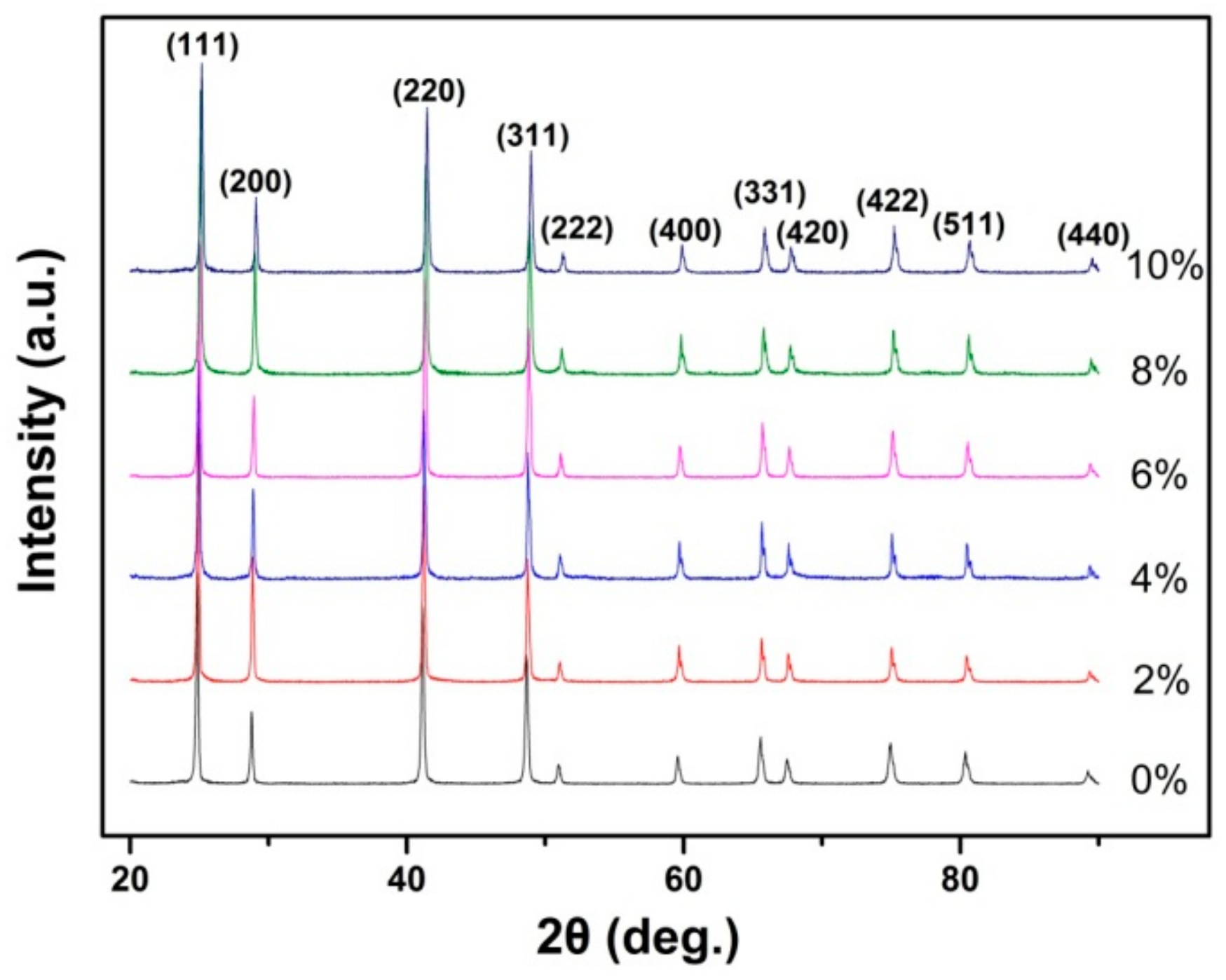
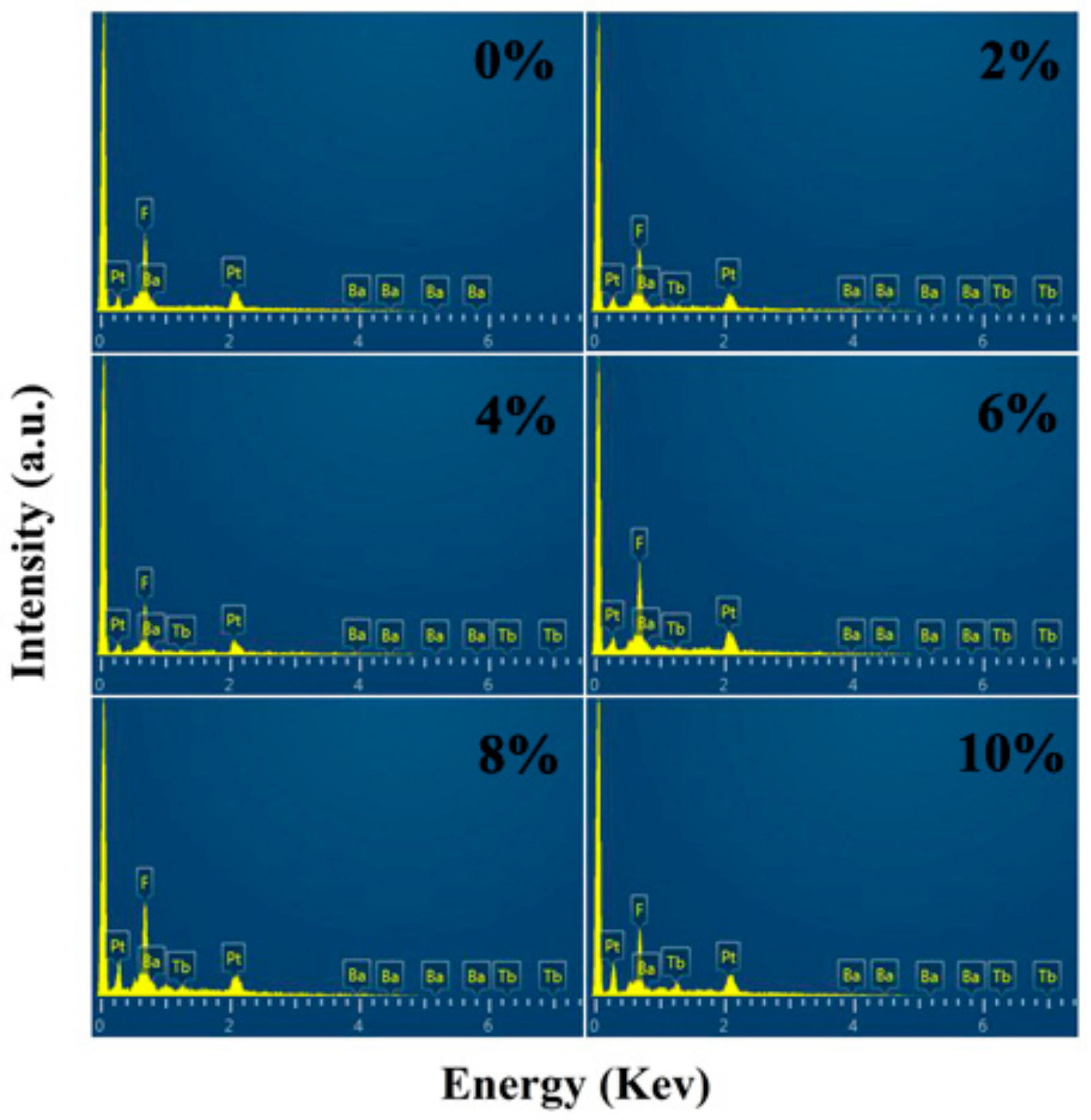
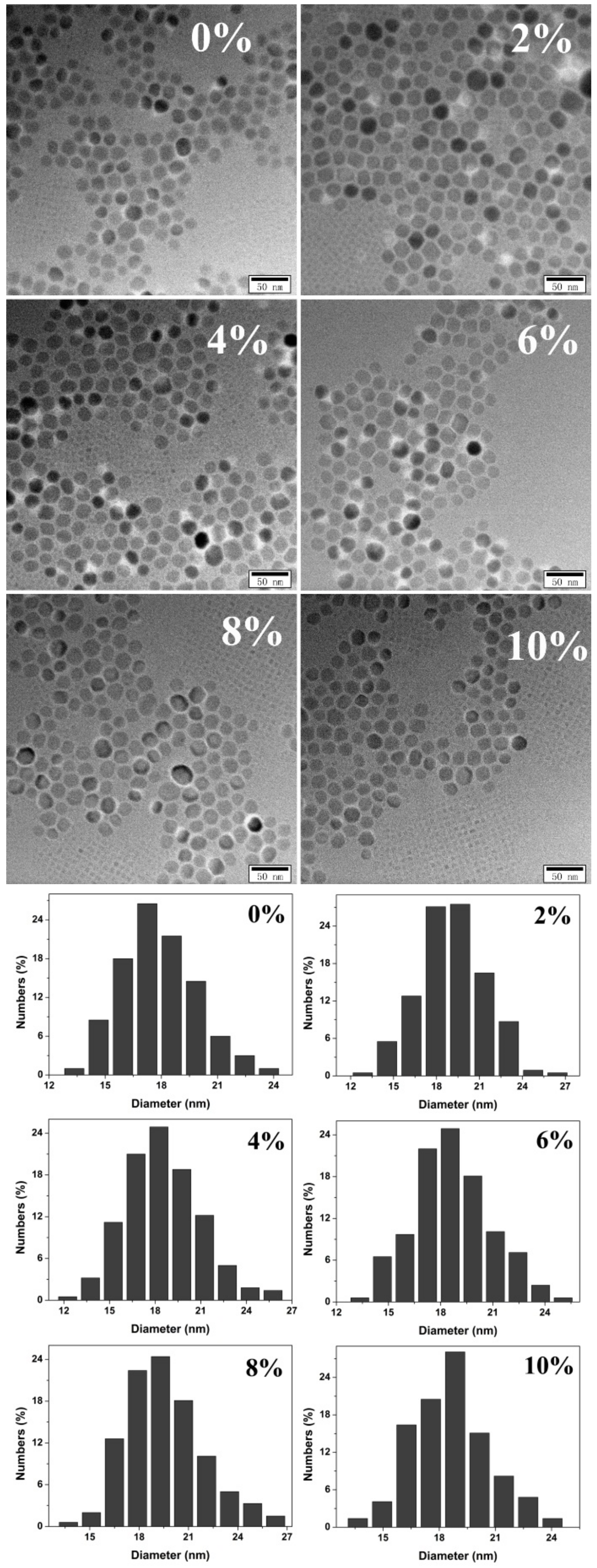
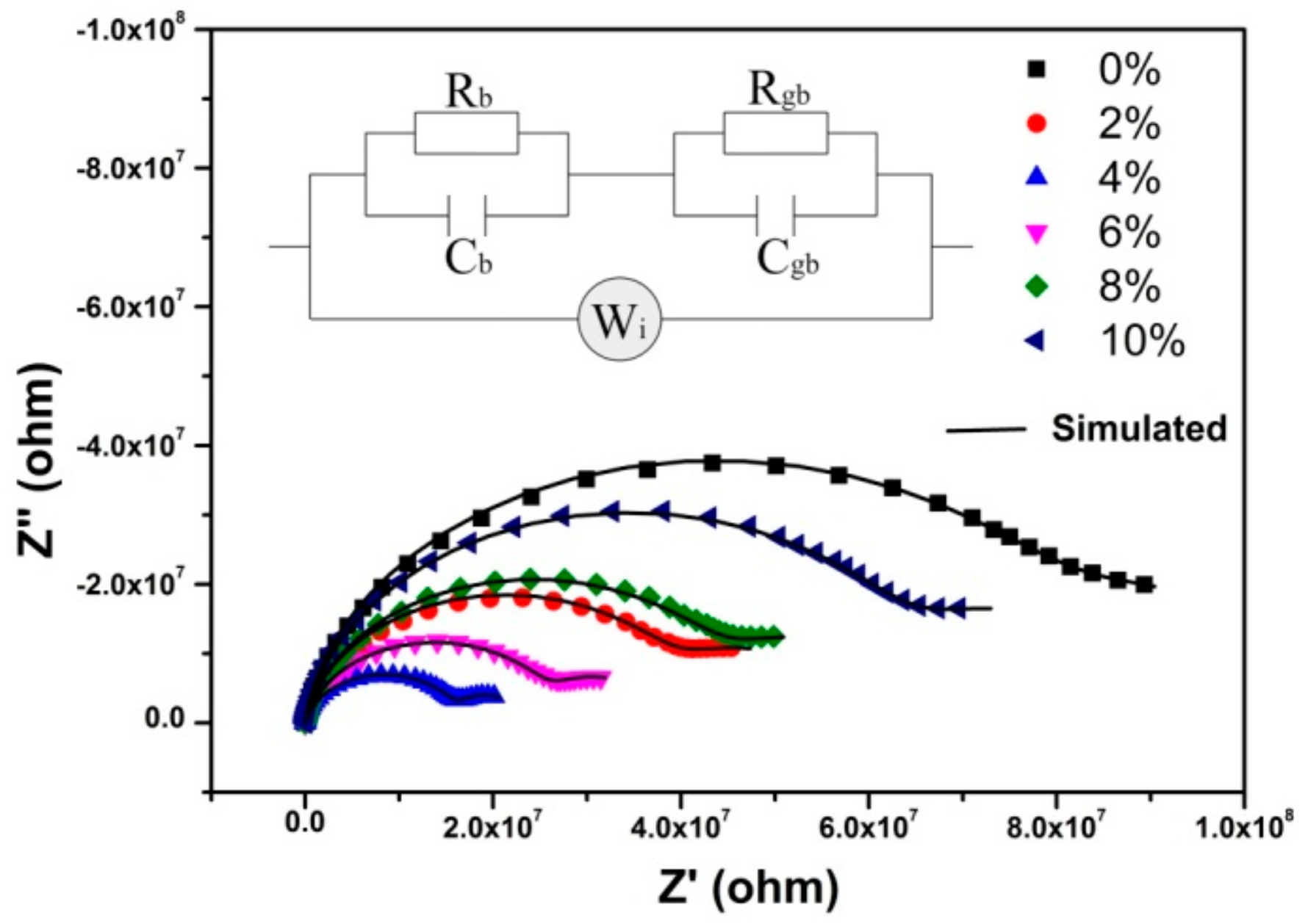
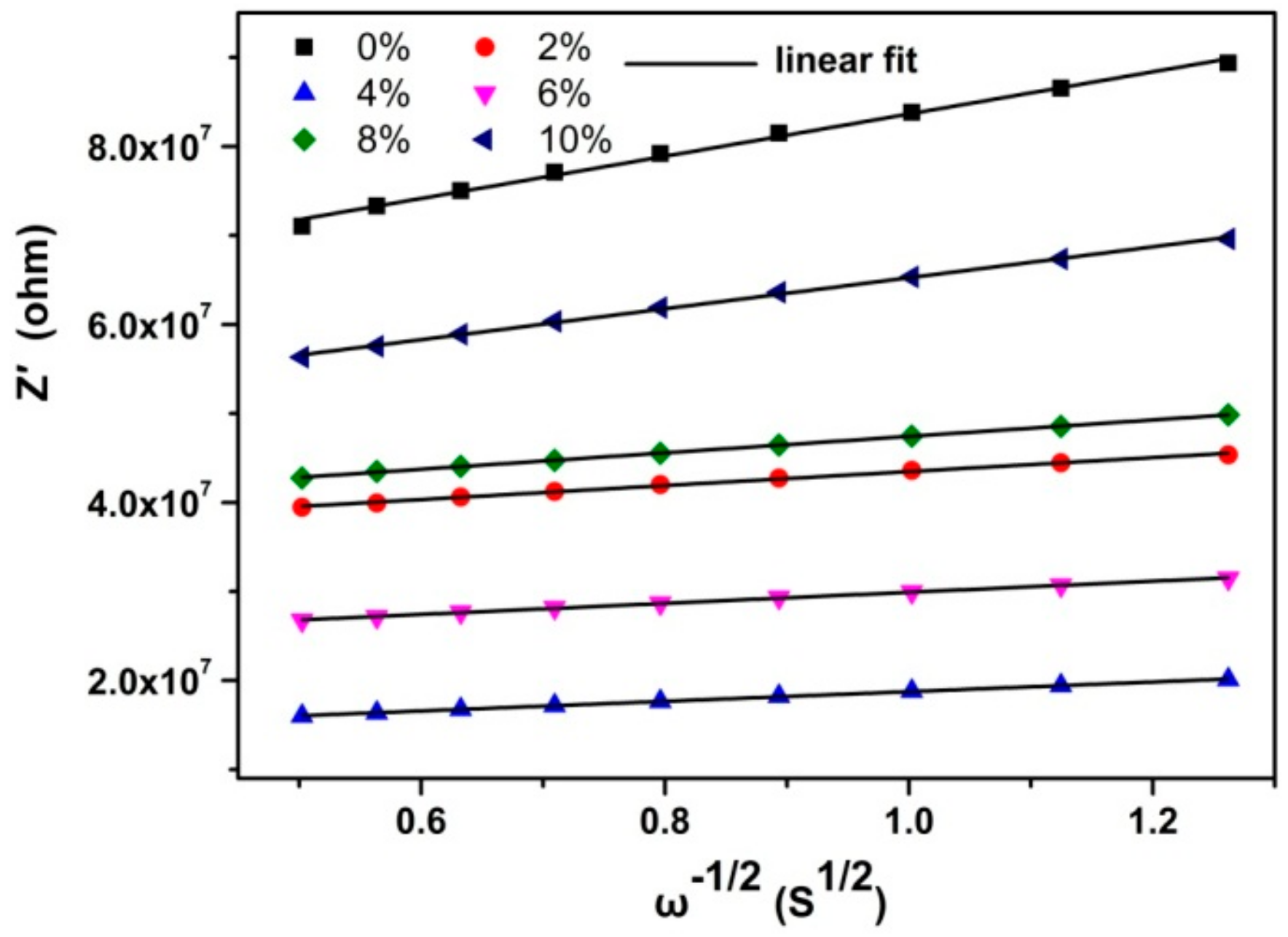

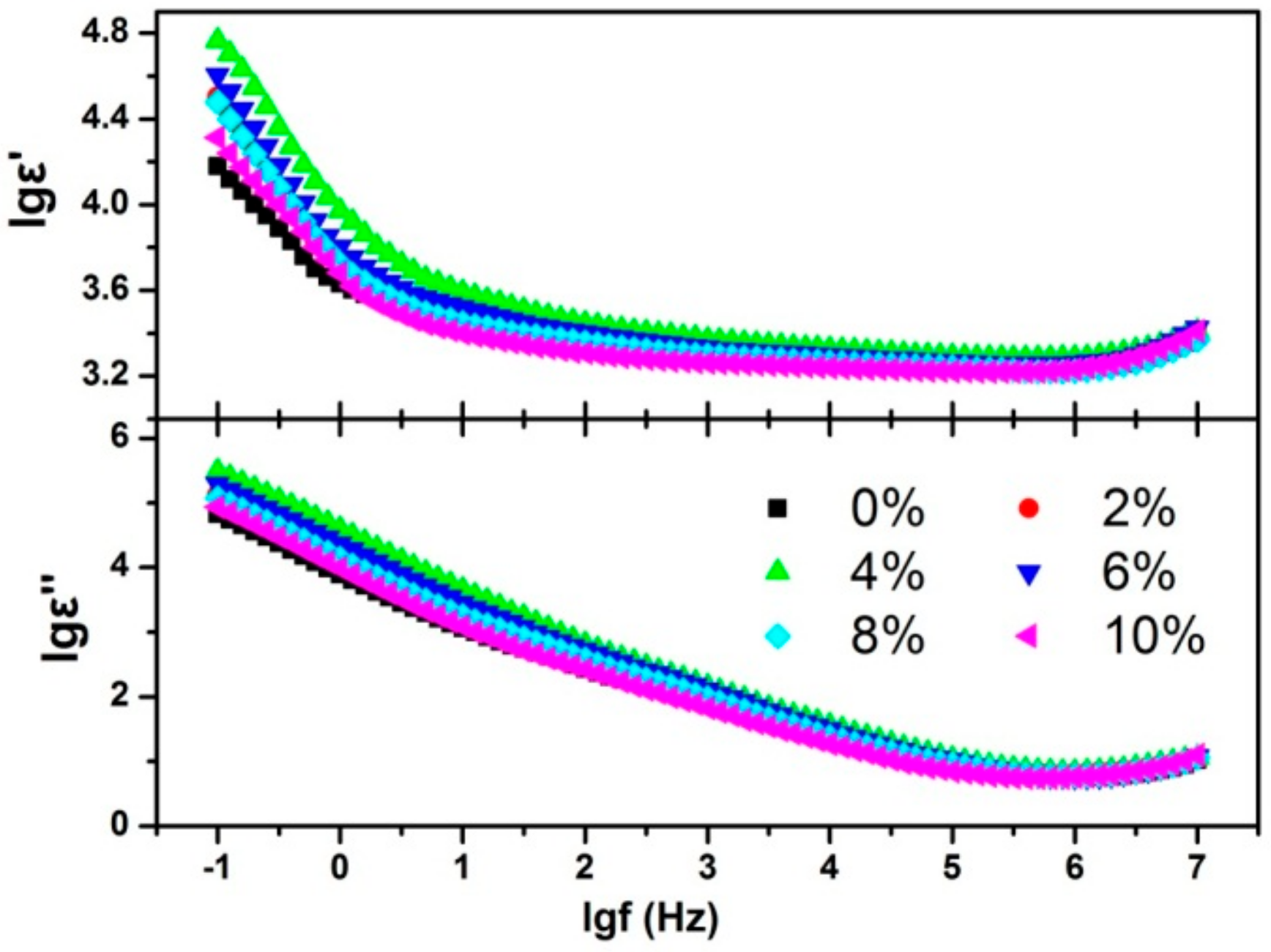
| Tb-Doped Concentration | Lattice Constant (Å) | Cell Volume (Å3) |
|---|---|---|
| 0% | 6.2025 | 238.619 |
| 2% | 6.1945 | 237.696 |
| 4% | 6.1883 | 236.991 |
| 6% | 6.1818 | 236.238 |
| 8% | 6.1700 | 234.887 |
| 10% | 6.1545 | 233.127 |
© 2020 by the authors. Licensee MDPI, Basel, Switzerland. This article is an open access article distributed under the terms and conditions of the Creative Commons Attribution (CC BY) license (http://creativecommons.org/licenses/by/4.0/).
Share and Cite
Cui, X.; Hu, T.; Wu, H.; Zhang, J.; Yang, L.; Zhong, X.; Wu, X.; Wang, J.; Li, X.; Yang, J.; et al. Charge Carrier Transport Behavior and Dielectric Properties of BaF2:Tb3+ Nanocrystals. Nanomaterials 2020, 10, 155. https://doi.org/10.3390/nano10010155
Cui X, Hu T, Wu H, Zhang J, Yang L, Zhong X, Wu X, Wang J, Li X, Yang J, et al. Charge Carrier Transport Behavior and Dielectric Properties of BaF2:Tb3+ Nanocrystals. Nanomaterials. 2020; 10(1):155. https://doi.org/10.3390/nano10010155
Chicago/Turabian StyleCui, Xiaoyan, Tingjing Hu, Huangyu Wu, Junkai Zhang, Lihua Yang, Xin Zhong, Xiaoxin Wu, Jingshu Wang, Xuefei Li, Jinghai Yang, and et al. 2020. "Charge Carrier Transport Behavior and Dielectric Properties of BaF2:Tb3+ Nanocrystals" Nanomaterials 10, no. 1: 155. https://doi.org/10.3390/nano10010155
APA StyleCui, X., Hu, T., Wu, H., Zhang, J., Yang, L., Zhong, X., Wu, X., Wang, J., Li, X., Yang, J., & Gao, C. (2020). Charge Carrier Transport Behavior and Dielectric Properties of BaF2:Tb3+ Nanocrystals. Nanomaterials, 10(1), 155. https://doi.org/10.3390/nano10010155





